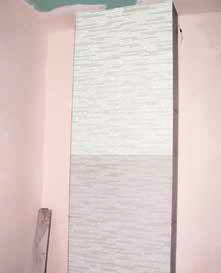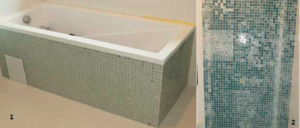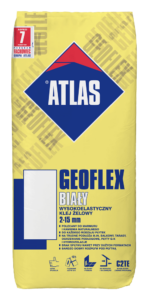- Products
- Systems
- Tools & Services
News
Why is it worth to use adhesives based on white cement?
Adhesives for tiles based on white Portland cement still represent a small share of all tile adhesives used in Europe. According to our estimates, the share of white cement based adhesives for ceramic and stone tiles on the Polish market is just about 1.5% and even less in case of adhesives for thermal insulation. To make the matter even more interesting, white adhesives have excellent technical parameters and their application range is wider than traditional grey cement based adhesives.
Adhesives based on white cement have yet one, unique but extremely important feature which should be appreciated by every contractor – they give a certain margin for mistakes. We will look into this matter further in the text.
Properties of white cement
Both white and grey Portland cement are manufactured in result of very similar technological processes. However, they differ in three essential aspects – type of raw materials used, stoving temperature and grinding level. The white cement is made from carefully selected raw materials which contain negligible amount of impurities and coloring oxides (iron, manganese, titanium or chromium oxides) – they usually do not exceed 0.3% of Portland clinker mass. The material called kaolin is often combined with chalk or high quality limestone. During the manufacturing process the ingredients are very precisely grinded in mills with special accessories (nickel balls). In result, one obtains binder of very bright, almost pure white colour. In comparison to grey cement, the manufacturing process of white cement requires much higher temperature in the furnace (approx. 20%), which results in higher production costs (white cement is approx. 50% more expensive than grey one). The final result, namely the white Portland cement is all in all the binder which is worth its price, because:
– it has constant and stable strength parameters,
– it contains very little amount of impurities,
– it allows the manufacturers to produce building mortars which are colored in the mass, e.g. mineral renders and mortars for tiles grouting,
– it easily binds with pigments and makes it possible to dye the mortar into different colors, depending on purpose.
|
Type of rock |
Name of rock |
Frost resistance |
Absorptivity [%] |
Risk of discoloration |
|
NATURAL ROCKS (igneous rocks, sedimentary rocks, metamorphic rocks) |
basalt |
*** |
0.05 – 2.0 |
does not occur |
|
granite |
*** |
0.1 – 1.0 |
occurs |
|
|
syenite |
*** |
0.2 – 0.6 |
does not occur |
|
|
diorite |
*** |
0.1 – 1.0 |
occurs |
|
|
sandstone |
** |
0.5 – 15.0 |
occurs |
|
|
limestone |
* |
0.1 – 1.2 |
occurs rarely |
|
|
travertine |
** |
0.5 – 4.0 |
occurs rarely |
|
|
gneiss |
*** |
0.2 – 1.5 |
occurs |
|
|
schist |
* |
0.2 – 0.4 |
does not occur |
|
|
marble |
** |
0.1 – 3.0 |
occurs |
|
|
quartzite |
*** |
0.1 – 0.4 |
does not occur |
|
|
ARTIFICIAL ROCKS |
conglomerate |
*** |
4.0 – 10.0 |
occurs |
White and grey Portland cement
Cement adhesives for tiles are building mortars manufactured as ready-to-use (after mixing with water) compounds containing binder, aggregate of different grain size and carefully selected modifying additives. The ratio of binder, i.e. Portland cement is usually from 20 up to 40% of the mortar mass. It is the most important component, which in practice determines the strength and bonding between the adhesive and the substrate. Contrarily to one popular opinion, the adhesives based on white Portland cement and grey Portland cement do not differ only in colour of the binder. Various properties of these two types of cement impose the use of diverse volumes of binders. The types of modifying additives, which affect the working parameters and the properties of prepared adhesive, are not necessarily the same as well.
What is more, due to the expected light colour of the adhesive mortar, slightly different type of quartz aggregate is also necessary – the aggregate of brighter colour and different type of dust are required in the white adhesives compositions.
When should we use white adhesives?
Building practice shows that the use of adhesives based on the white cement is particularly justified when one is not entirely sure about the properties of a tile to be fixed. This applies in particular to:
– natural stone tiles, especially those sold in DIY markets, e.g. imported from China,
– tiles made of artificial stone (conglomerate),
– several types of polished porcelain-gres tiles,
– glass and stone mosaic,
– glass tiles, especially of bright colour or bright print.
In case of these types of tiles, due to their specific properties, the use of adhesives based on grey cement can cause their permanent discoloration.
Stone and porcelain-gres tiles
Natural or artificial stone and porcelain-gres tiles are vulnerable to discoloration. Due to high absorptiveness of the tile surface and its internal structure characteristics the colour can change. The structure of the tiles composes of capillary tubes (they are sometimes called micropores) of different shape, cross-section and diameter. Structural micropores can be divided into: open, merging, those of continuous form and closed ones which are surrounded from all sides to form voids in the material. Their size, number and diameter determine not only the porosity and absorption, but also the stone vulnerability to moisture contained in the mortar. When the tile is pressed against the layer of spread and formed adhesive mortar, the bottom side of the tile is moistened with the water previously added to the mortar. Contamination contained in the aggregate, chemical compounds from water as well as the components of grey cement are transported through water and micropores deep into the tile structure. After water evaporation they remain inside the micropores and form unaesthetic and permanent discoloration of the tile surface visible to the naked eye.
Glass tiles
In case of glass tiles, especially those colored in bright, pastel colors, stains are formed as the result of damage of the tile backside by highly alkaline cement adhesive, or simply by uniform, dark colour of the background (because of natural, grey or dark grey colour of the adhesive mortar). Moreover, in case of glass tiles, it is also possible that stains or discoloration will appear on the tiles surface as the result of incomplete filling the space between the bottom of the tile and the substrate with the adhesive – it can happen, for example, at points where the traces of the trowel notches are left unfilled (there is too little adhesive applied). In such cases, one can spot characteristic bright spots in the areas where there is no bonding between the tile and the adhesive.
|
GOOD TO KNOW Adhesive for tiles based on white cement gives a contractor some margin for error during the assessment of the tiles characteristics. White cement based adhesive makes it possible to avoid problems and unexpected costs related with unaesthetic discoloration or stains on just applied cladding made of highly absorbable tiles or glass tiles. |
|
ATTENTION In case of thin marble tiles, the discoloration can be an issue despite the use of the white cement based adhesive. However, this discoloration is only temporary. It is caused by very high absorptivity of marble and use of very thin tiles. The fixed tiles will restore their original colour after about a week since the application. It corresponds with the time the adhesive needs to dry completely. |
Why not to do a trial?
Is it possible to check whether a given tile is vulnerable to temporary or permanent discoloration? Or is it possible to determine whether particular mosaic or glass tile will change in colour? Of course one can rely on distributor’s or manufacturer’s declarations or information. On the other hand, one can do a trial – this is the approach we recommend. The trial consists of so-called test application which must be carried out 2 or 3 days before proper tiling. One must lay at least one tile of the same type as the tiles which are going to be used on the entire surface. The bonding surface beneath the tile should be filled in 60%, whereas the remaining 40% of the tile bottom surface should be free of the adhesive. After aforementioned 2 or 3 days, one may assess the appearance of the tile bonded in such way. The test result is positive if one does not see the difference in appearance between both sides of the tile (bonded with adhesive and free of adhesive). Only then one can start to fix the tiles, keeping in mind the adhesive and tiles manufacturer’s recommendations and good tiling practice.
Attention
If there are any doubts whether a given adhesive may permanently discolor the tiles or influence their appearance, one should not take a risk. Stone tiles are usually quite expensive and potential discoloration of the surface is permanent and cannot be removed or even minimized. The tiles discolored by the grey adhesive mortar would not regain their original colour and it is rather hard to expect that the investor would accept changed colour – this is why we earlier mentioned about the margin for an error. Given all of the above, the new ATLAS adhesive based on white Portland cement will perform superbly in tiling works no matter the type, characteristics and absorptivity of the tiles.
|
In case of trouble – ATLAS GEOFLEX WHITE
|
|
|
|
The new Atlas Geoflex White adhesive is, first of all, the continuation of our extremely successful gel revolution initiated by the Atlas Geoflex adhesive. It’s also a perfect complement of Atlas current portfolio of tiling products. This time the adhesive composition includes also the same state-of-the-art silica gel technology. Silica gel has one outstanding feature – it binds portion of water during the adhesive binding and therefore provides full hydration of the cement binder, regardless the type of the adhesive applied. It is due to proper water management, which is necessary to complete the binding process, why the gel adhesive obtains such good bonding to the substrate of different levels of absorptivity. Both this property and the bright colour of the mortar (resulting from the use of white Portland cement as the binder) make Atlas Geoflex White an irreplaceable product particularly when fixing the tiles vulnerable to discoloration or stains. Most important features
Atlas Geoflex White It is classified and labelled in accordance to PN-EN 12004+A1:2012 standard as a C2TE adhesion mortar, which means that Atlas Geoflex White has improved parameters (bonding after 28 days ≥ 1.0 N/mm2), extended open time (time between application of the adhesive and placing the tile can be up to 30 minutes) and reduced slip (it does not exceed 0.5 mm). It is designed to be used indoors and outdoors to fix tiles both on walls and floors. It has the EC Declaration of Performance No. 186/CPR. The technical data sheet, Declaration of Performance and other reference documentation one may find on www.atlas.com.pl/en. |
Original text: Sebastian Czernik, ATLAS Group
English text: Piotr Marciniak, ATLAS Group














